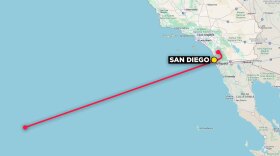One of the world's most famous and oldest spacecraft is revealing some of its past. Apollo 11 was the first mission to land humans on the moon. As Neil Armstrong and Buzz Aldrin walked on the lunar surface, Michael Collins circled above in the command module called Columbia.
Columbia is where the three astronauts lived during most of the eight-day mission in July 1969. It's the only part of the spacecraft that returned to Earth, and it's been at the Smithsonian since 1970 and at the National Air and Space Museum in Washington, D.C., since it opened in 1976.


Museum guests are able to peer inside the windows of the cramped, 10-by-12-foot, cone-shaped capsule and look at the flight controls, navigation equipment and the three uncomfortable-looking seats. What they haven't been able to see are markings hidden from view for the past 47 years.
Workers at the Air and Space Museum have been scanning the spacecraft for a 3-D digitization project. Once inside, they found writing on the interior walls of the command module. "They can be seen by the human eye if you were to go into the Command Module, which of course no one can normally do. We were able to take these photos because we allowed one of our conservators to go in, very strategically and carefully," Alison Mitchell of the Air and Space Museum told NPR in an email.
In both pen and pencil, the astronauts scribbled down flight plans, a series of numbers and notations from mission control, and a calendar. Each day of the Apollo 11 mission is crossed out except for the final day, July 24, when Columbia returned to Earth.
Curators are now studying the text and cross-referencing flight transcripts to get a more complete account and understanding of the lunar mission. They're still not sure what the markings were all for or which astronauts wrote them.
The Smithsonian 3-D scanning project will give researchers and the public a high-resolution and interactive model of the Apollo 11 spacecraft when it's completed this June.
Copyright 2022 NPR. To see more, visit https://www.npr.org. 9(MDAzMjM2NDYzMDEyMzc1Njk5NjAxNzY3OQ001))








